1997 MERCEDES-BENZ ML350 manual transmission
[x] Cancel search: manual transmissionPage 2864 of 4133
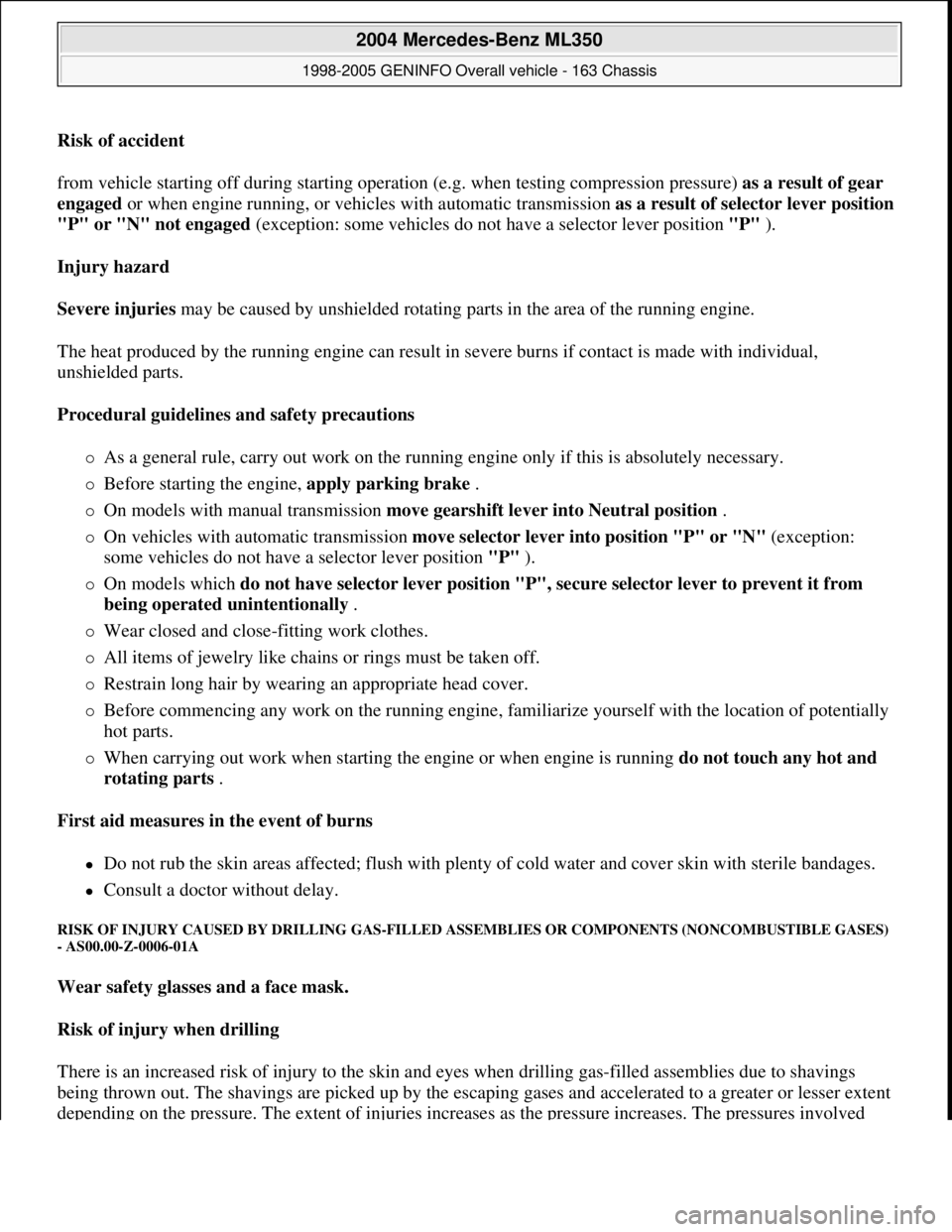
Risk of accident
from vehicle starting off during starting operation (e.g. when testing compression pressure) as a result of gear
engaged or when engine running, or vehicles with automatic transmission as a result of selector lever position
"P" or "N" not engaged (exception: some vehicles do not have a selector lever position "P" ).
Injury hazard
Severe injuries may be caused by unshielded rotating parts in the area of the running engine.
The heat produced by the running engine can result in severe burns if contact is made with individual,
unshielded parts.
Procedural guidelines and safety precautions
As a general rule, carry out work on the running engine only if this is absolutely necessary.
Before starting the engine, apply parking brake .
On models with manual transmission move gearshift lever into Neutral position .
On vehicles with automatic transmission move selector lever into position "P" or "N" (exception:
some vehicles do not have a selector lever position "P" ).
On models which do not have selector lever position "P", secure selector lever to prevent it from
being operated unintentionally .
Wear closed and close-fitting work clothes.
All items of jewelry like chains or rings must be taken off.
Restrain long hair by wearing an appropriate head cover.
Before commencing any work on the running engine, familiarize yourself with the location of potentially
hot parts.
When carrying out work when starting the engine or when engine is running do not touch any hot and
rotating parts .
First aid measures in the event of burns
Do not rub the skin areas affected; flush with plenty of cold water and cover skin with sterile bandages.
Consult a doctor without delay.
RISK OF INJURY CAUSED BY DRILLING GAS-FILLED ASSEMBLIES OR COMPONENTS (NONCOMBUSTIBLE GASES)
- AS00.00-Z-0006-01A
Wear safety glasses and a face mask.
Risk of injury when drilling
There is an increased risk of injury to the skin and eyes when drilling gas-filled assemblies due to shavings
being thrown out. The shavings are picked up by the escaping gases and accelerated to a greater or lesser extent
depending on the pressure. The extent of injuries increases as the pressure increases. The pressures involved
2004 Mercedes-Benz ML350
1998-2005 GENINFO Overall vehicle - 163 Chassis
me
Saturday, October 02, 2010 3:47:47 PMPage 219 © 2006 Mitchell Repair Information Company, LLC.
Page 3046 of 4133
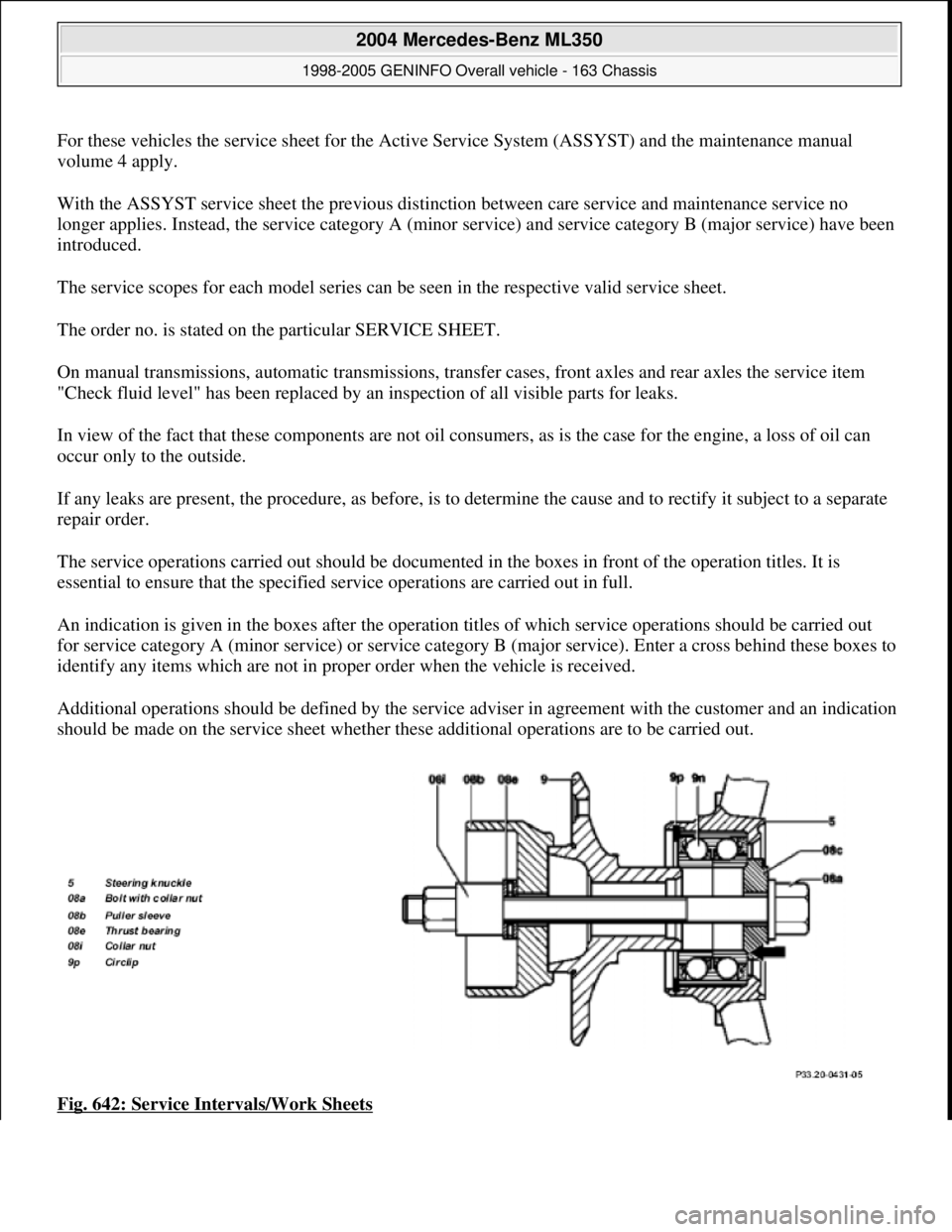
For these vehicles the service sheet for the Active Service System (ASSYST) and the maintenance manual
volume 4 apply.
With the ASSYST service sheet the previous distinction between care service and maintenance service no
longer applies. Instead, the service category A (minor service) and service category B (major service) have been
introduced.
The service scopes for each model series can be seen in the respective valid service sheet.
The order no. is stated on the particular SERVICE SHEET.
On manual transmissions, automatic transmissions, transfer cases, front axles and rear axles the service item
"Check fluid level" has been replaced by an inspection of all visible parts for leaks.
In view of the fact that these components are not oil consumers, as is the case for the engine, a loss of oil can
occur only to the outside.
If any leaks are present, the procedure, as before, is to determine the cause and to rectify it subject to a separate
repair order.
The service operations carried out should be documented in the boxes in front of the operation titles. It is
essential to ensure that the specified service operations are carried out in full.
An indication is given in the boxes after the operation titles of which service operations should be carried out
for service category A (minor service) or service category B (major service). Enter a cross behind these boxes to
identify any items which are not in proper order when the vehicle is received.
Additional operations should be defined by the service adviser in agreement with the customer and an indication
should be made on the service sheet whether these additional operations are to be carried out.
Fig. 642: Service Intervals/Work Sheets
2004 Mercedes-Benz ML350
1998-2005 GENINFO Overall vehicle - 163 Chassis
me
Saturday, October 02, 2010 3:47:52 PMPage 401 © 2006 Mitchell Repair Information Company, LLC.
Page 3048 of 4133
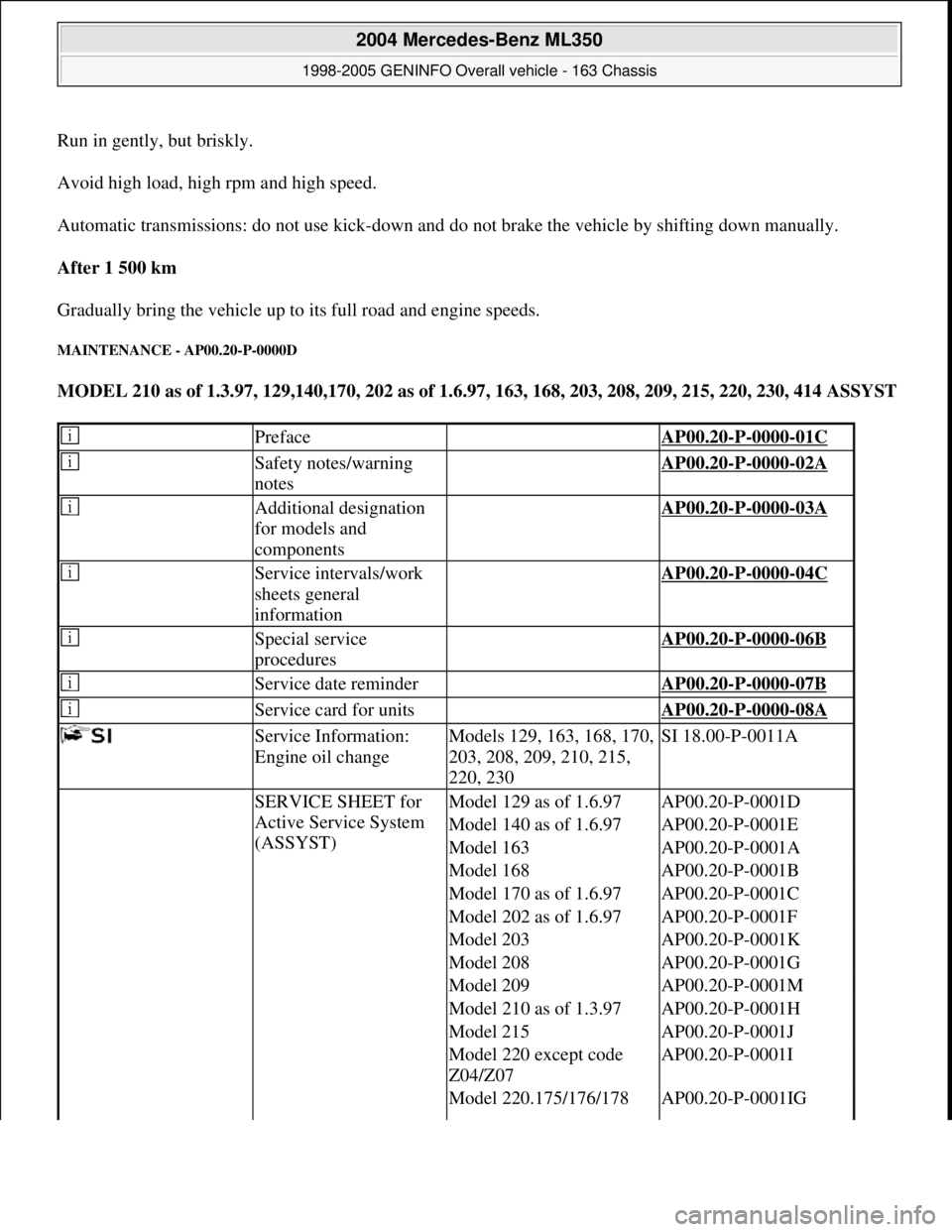
Run in gently, but briskly.
Avoid high load, high rpm and high speed.
Automatic transmissions: do not use kick-down and do not brake the vehicle by shifting down manually.
After 1 500 km
Gradually bring the vehicle up to its full road and engine speeds.
MAINTENANCE - AP00.20-P-0000D
MODEL 210 as of 1.3.97, 129,140,170, 202 as of 1.6.97, 163, 168, 203, 208, 209, 215, 220, 230, 414 ASSYST
Preface AP00.20-P-0000-01C
Safety notes/warning
notes AP00.20-P-0000-02A
Additional designation
for models and
components AP00.20-P-0000-03A
Service intervals/work
sheets general
information AP00.20-P-0000-04C
Special service
procedures AP00.20-P-0000-06B
Service date reminder AP00.20-P-0000-07B
Service card for units AP00.20-P-0000-08A
Service Information:
Engine oil changeModels 129, 163, 168, 170,
203, 208, 209, 210, 215,
220, 230SI 18.00-P-0011A
SERVICE SHEET for
Active Service System
(ASSYST)Model 129 as of 1.6.97AP00.20-P-0001D
Model 140 as of 1.6.97AP00.20-P-0001E
Model 163AP00.20-P-0001A
Model 168AP00.20-P-0001B
Model 170 as of 1.6.97AP00.20-P-0001C
Model 202 as of 1.6.97AP00.20-P-0001F
Model 203AP00.20-P-0001K
Model 208AP00.20-P-0001G
Model 209AP00.20-P-0001M
Model 210 as of 1.3.97AP00.20-P-0001H
Model 215AP00.20-P-0001J
Model 220 except code
Z04/Z07AP00.20-P-0001I
Model 220.175/176/178 AP00.20-P-0001IG
2004 Mercedes-Benz ML350
1998-2005 GENINFO Overall vehicle - 163 Chassis
me
Saturday, October 02, 2010 3:47:52 PMPage 403 © 2006 Mitchell Repair Information Company, LLC.
Page 3146 of 4133
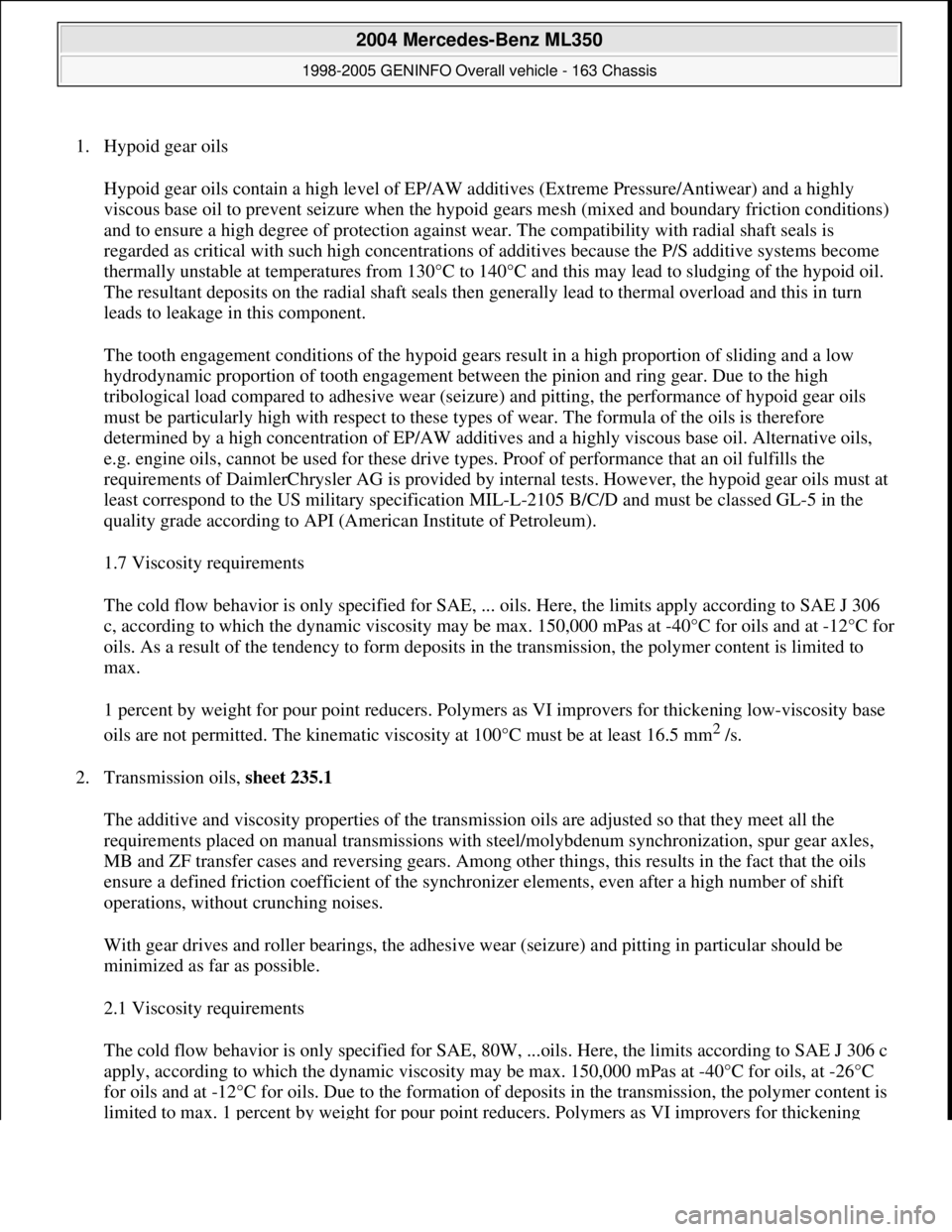
1. Hypoid gear oils
Hypoid gear oils contain a high level of EP/AW additives (Extreme Pressure/Antiwear) and a highly
viscous base oil to prevent seizure when the hypoid gears mesh (mixed and boundary friction conditions)
and to ensure a high degree of protection against wear. The compatibility with radial shaft seals is
regarded as critical with such high concentrations of additives because the P/S additive systems become
thermally unstable at temperatures from 130°C to 140°C and this may lead to sludging of the hypoid oil.
The resultant deposits on the radial shaft seals then generally lead to thermal overload and this in turn
leads to leakage in this component.
The tooth engagement conditions of the hypoid gears result in a high proportion of sliding and a low
hydrodynamic proportion of tooth engagement between the pinion and ring gear. Due to the high
tribological load compared to adhesive wear (seizure) and pitting, the performance of hypoid gear oils
must be particularly high with respect to these types of wear. The formula of the oils is therefore
determined by a high concentration of EP/AW additives and a highly viscous base oil. Alternative oils,
e.g. engine oils, cannot be used for these drive types. Proof of performance that an oil fulfills the
requirements of DaimlerChrysler AG is provided by internal tests. However, the hypoid gear oils must at
least correspond to the US military specification MIL-L-2105 B/C/D and must be classed GL-5 in the
quality grade according to API (American Institute of Petroleum).
1.7 Viscosity requirements
The cold flow behavior is only specified for SAE, ... oils. Here, the limits apply according to SAE J 306
c, according to which the dynamic viscosity may be max. 150,000 mPas at -40°C for oils and at -12°C for
oils. As a result of the tendency to form deposits in the transmission, the polymer content is limited to
max.
1 percent by weight for pour point reducers. Polymers as VI improvers for thickening low-viscosity base
oils are not permitted. The kinematic viscosity at 100°C must be at least 16.5 mm
2 /s.
2. Transmission oils, sheet 235.1
The additive and viscosity properties of the transmission oils are adjusted so that they meet all the
requirements placed on manual transmissions with steel/molybdenum synchronization, spur gear axles,
MB and ZF transfer cases and reversing gears. Among other things, this results in the fact that the oils
ensure a defined friction coefficient of the synchronizer elements, even after a high number of shift
operations, without crunching noises.
With gear drives and roller bearings, the adhesive wear (seizure) and pitting in particular should be
minimized as far as possible.
2.1 Viscosity requirements
The cold flow behavior is only specified for SAE, 80W, ...oils. Here, the limits according to SAE J 306 c
apply, according to which the dynamic viscosity may be max. 150,000 mPas at -40°C for oils, at -26°C
for oils and at -12°C for oils. Due to the formation of deposits in the transmission, the polymer content is
limited to max. 1 percent b
y weight for pour point reducers. Polymers as VI improvers for thickening
2004 Mercedes-Benz ML350
1998-2005 GENINFO Overall vehicle - 163 Chassis
me
Saturday, October 02, 2010 3:47:56 PMPage 501 © 2006 Mitchell Repair Information Company, LLC.
Page 3147 of 4133
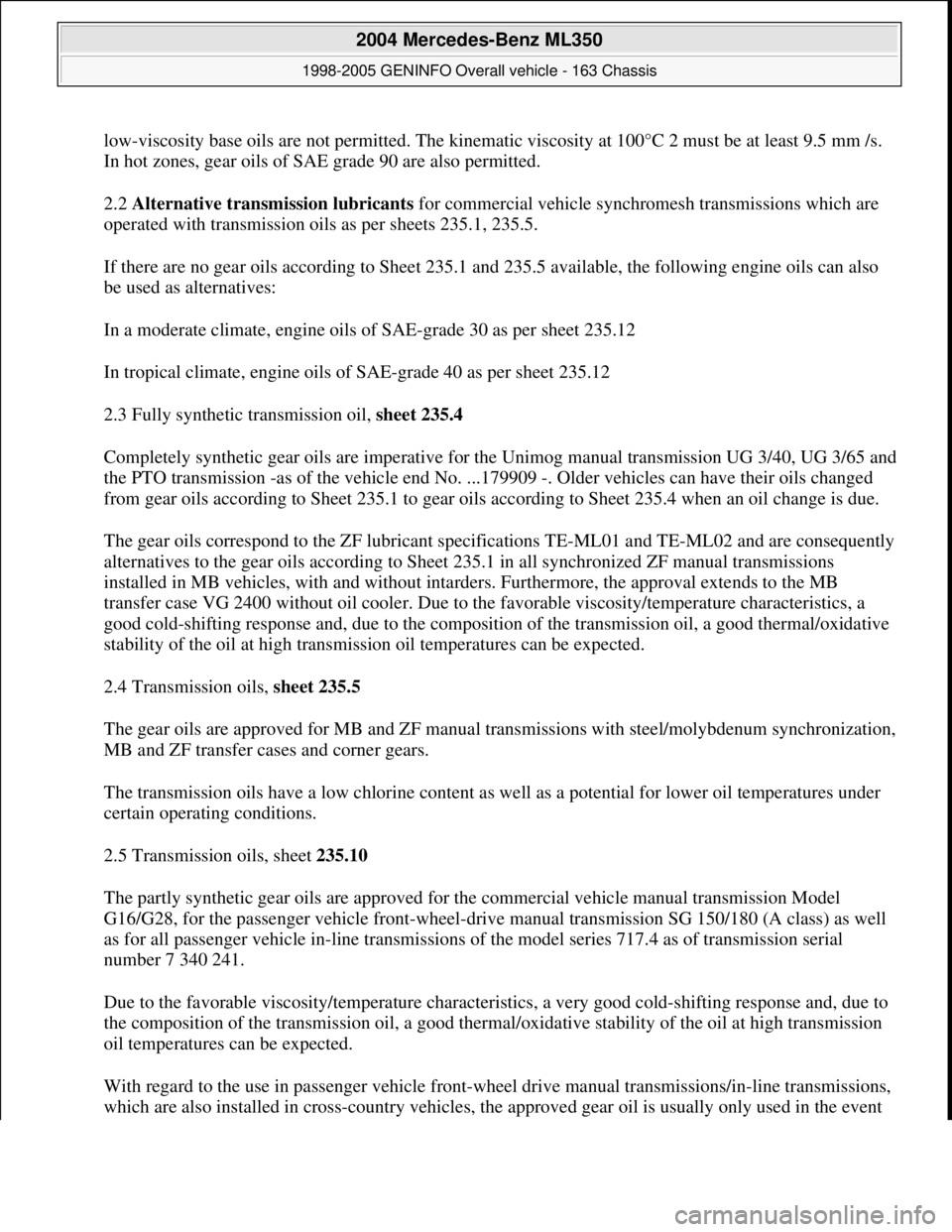
low-viscosity base oils are not permitted. The kinematic viscosity at 100°C 2 must be at least 9.5 mm /s.
In hot zones, gear oils of SAE grade 90 are also permitted.
2.2 Alternative transmission lubricants for commercial vehicle synchromesh transmissions which are
operated with transmission oils as per sheets 235.1, 235.5.
If there are no gear oils according to Sheet 235.1 and 235.5 available, the following engine oils can also
be used as alternatives:
In a moderate climate, engine oils of SAE-grade 30 as per sheet 235.12
In tropical climate, engine oils of SAE-grade 40 as per sheet 235.12
2.3 Fully synthetic transmission oil, sheet 235.4
Completely synthetic gear oils are imperative for the Unimog manual transmission UG 3/40, UG 3/65 and
the PTO transmission -as of the vehicle end No. ...179909 -. Older vehicles can have their oils changed
from gear oils according to Sheet 235.1 to gear oils according to Sheet 235.4 when an oil change is due.
The gear oils correspond to the ZF lubricant specifications TE-ML01 and TE-ML02 and are consequently
alternatives to the gear oils according to Sheet 235.1 in all synchronized ZF manual transmissions
installed in MB vehicles, with and without intarders. Furthermore, the approval extends to the MB
transfer case VG 2400 without oil cooler. Due to the favorable viscosity/temperature characteristics, a
good cold-shifting response and, due to the composition of the transmission oil, a good thermal/oxidative
stability of the oil at high transmission oil temperatures can be expected.
2.4 Transmission oils, sheet 235.5
The gear oils are approved for MB and ZF manual transmissions with steel/molybdenum synchronization,
MB and ZF transfer cases and corner gears.
The transmission oils have a low chlorine content as well as a potential for lower oil temperatures under
certain operating conditions.
2.5 Transmission oils, sheet 235.10
The partly synthetic gear oils are approved for the commercial vehicle manual transmission Model
G16/G28, for the passenger vehicle front-wheel-drive manual transmission SG 150/180 (A class) as well
as for all passenger vehicle in-line transmissions of the model series 717.4 as of transmission serial
number 7 340 241.
Due to the favorable viscosity/temperature characteristics, a very good cold-shifting response and, due to
the composition of the transmission oil, a good thermal/oxidative stability of the oil at high transmission
oil temperatures can be expected.
With regard to the use in passenger vehicle front-wheel drive manual transmissions/in-line transmissions,
which are also installed in cross-countr
y vehicles, the approved gear oil is usually only used in the event
2004 Mercedes-Benz ML350
1998-2005 GENINFO Overall vehicle - 163 Chassis
me
Saturday, October 02, 2010 3:47:56 PMPage 502 © 2006 Mitchell Repair Information Company, LLC.
Page 3148 of 4133
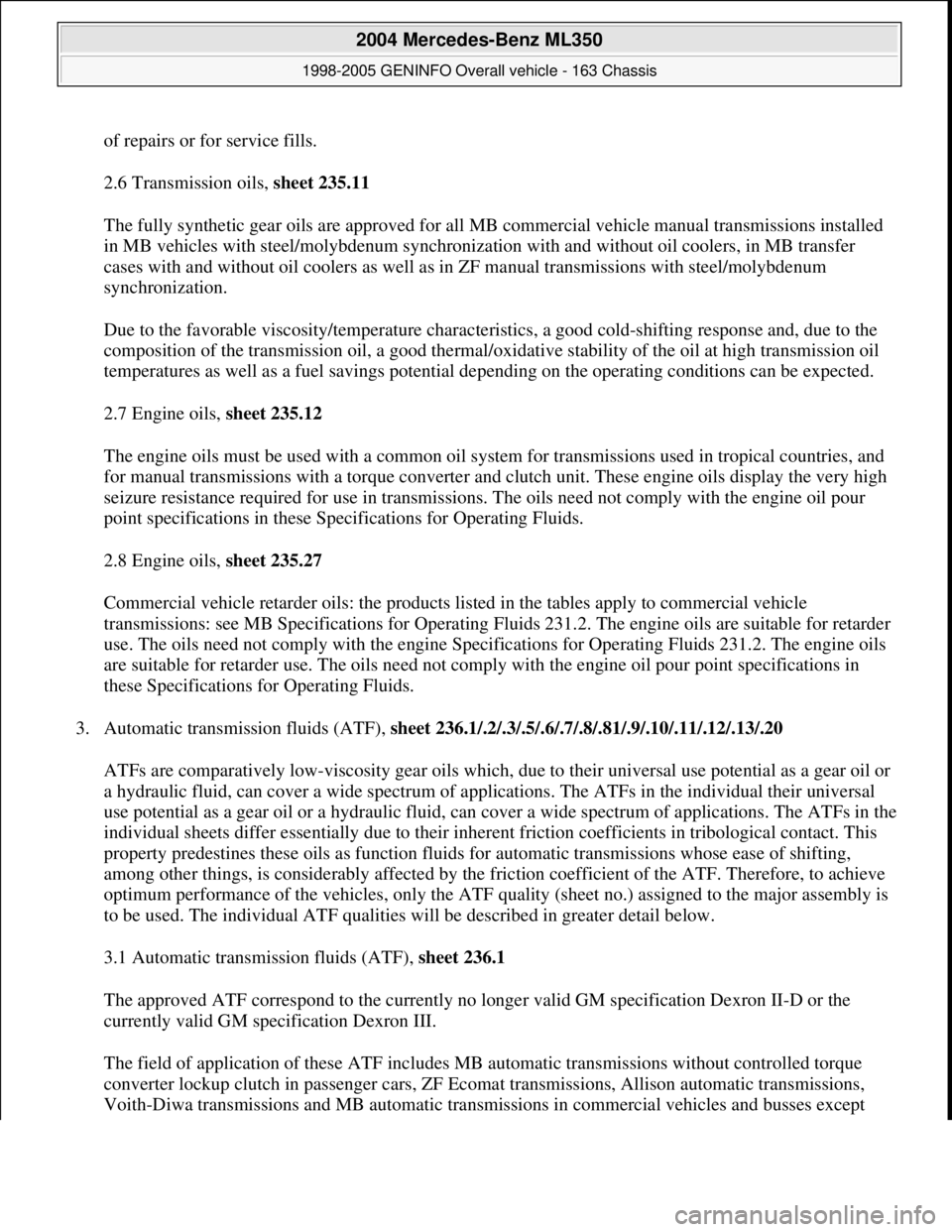
of repairs or for service fills.
2.6 Transmission oils, sheet 235.11
The fully synthetic gear oils are approved for all MB commercial vehicle manual transmissions installed
in MB vehicles with steel/molybdenum synchronization with and without oil coolers, in MB transfer
cases with and without oil coolers as well as in ZF manual transmissions with steel/molybdenum
synchronization.
Due to the favorable viscosity/temperature characteristics, a good cold-shifting response and, due to the
composition of the transmission oil, a good thermal/oxidative stability of the oil at high transmission oil
temperatures as well as a fuel savings potential depending on the operating conditions can be expected.
2.7 Engine oils, sheet 235.12
The engine oils must be used with a common oil system for transmissions used in tropical countries, and
for manual transmissions with a torque converter and clutch unit. These engine oils display the very high
seizure resistance required for use in transmissions. The oils need not comply with the engine oil pour
point specifications in these Specifications for Operating Fluids.
2.8 Engine oils, sheet 235.27
Commercial vehicle retarder oils: the products listed in the tables apply to commercial vehicle
transmissions: see MB Specifications for Operating Fluids 231.2. The engine oils are suitable for retarder
use. The oils need not comply with the engine Specifications for Operating Fluids 231.2. The engine oils
are suitable for retarder use. The oils need not comply with the engine oil pour point specifications in
these Specifications for Operating Fluids.
3. Automatic transmission fluids (ATF), sheet 236.1/.2/.3/.5/.6/.7/.8/.81/.9/.10/.11/.12/.13/.20
ATFs are comparatively low-viscosity gear oils which, due to their universal use potential as a gear oil or
a hydraulic fluid, can cover a wide spectrum of applications. The ATFs in the individual their universal
use potential as a gear oil or a hydraulic fluid, can cover a wide spectrum of applications. The ATFs in the
individual sheets differ essentially due to their inherent friction coefficients in tribological contact. This
property predestines these oils as function fluids for automatic transmissions whose ease of shifting,
among other things, is considerably affected by the friction coefficient of the ATF. Therefore, to achieve
optimum performance of the vehicles, only the ATF quality (sheet no.) assigned to the major assembly is
to be used. The individual ATF qualities will be described in greater detail below.
3.1 Automatic transmission fluids (ATF), sheet 236.1
The approved ATF correspond to the currently no longer valid GM specification Dexron II-D or the
currently valid GM specification Dexron III.
The field of application of these ATF includes MB automatic transmissions without controlled torque
converter lockup clutch in passenger cars, ZF Ecomat transmissions, Allison automatic transmissions,
Voith-Diwa transmissions and MB automatic transmissions in commercial vehicles and busses except
2004 Mercedes-Benz ML350
1998-2005 GENINFO Overall vehicle - 163 Chassis
me
Saturday, October 02, 2010 3:47:56 PMPage 503 © 2006 Mitchell Repair Information Company, LLC.
Page 3149 of 4133
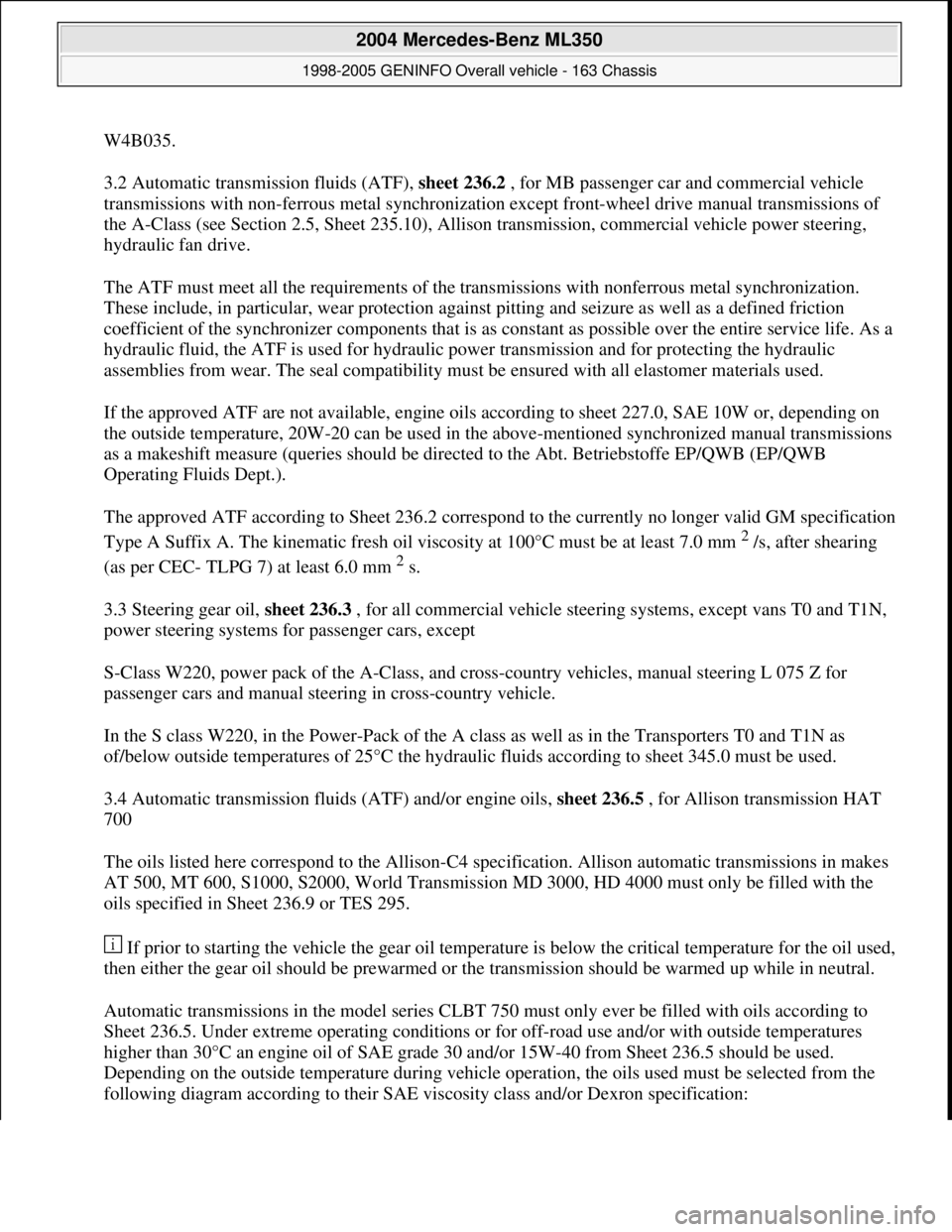
W4B035.
3.2 Automatic transmission fluids (ATF), sheet 236.2 , for MB passenger car and commercial vehicle
transmissions with non-ferrous metal synchronization except front-wheel drive manual transmissions of
the A-Class (see Section 2.5, Sheet 235.10), Allison transmission, commercial vehicle power steering,
hydraulic fan drive.
The ATF must meet all the requirements of the transmissions with nonferrous metal synchronization.
These include, in particular, wear protection against pitting and seizure as well as a defined friction
coefficient of the synchronizer components that is as constant as possible over the entire service life. As a
hydraulic fluid, the ATF is used for hydraulic power transmission and for protecting the hydraulic
assemblies from wear. The seal compatibility must be ensured with all elastomer materials used.
If the approved ATF are not available, engine oils according to sheet 227.0, SAE 10W or, depending on
the outside temperature, 20W-20 can be used in the above-mentioned synchronized manual transmissions
as a makeshift measure (queries should be directed to the Abt. Betriebstoffe EP/QWB (EP/QWB
Operating Fluids Dept.).
The approved ATF according to Sheet 236.2 correspond to the currently no longer valid GM specification
Type A Suffix A. The kinematic fresh oil viscosity at 100°C must be at least 7.0 mm
2 /s, after shearing
(as per CEC- TLPG 7) at least 6.0 mm
2 s.
3.3 Steering gear oil, sheet 236.3 , for all commercial vehicle steering systems, except vans T0 and T1N,
power steering systems for passenger cars, except
S-Class W220, power pack of the A-Class, and cross-country vehicles, manual steering L 075 Z for
passenger cars and manual steering in cross-country vehicle.
In the S class W220, in the Power-Pack of the A class as well as in the Transporters T0 and T1N as
of/below outside temperatures of 25°C the hydraulic fluids according to sheet 345.0 must be used.
3.4 Automatic transmission fluids (ATF) and/or engine oils, sheet 236.5 , for Allison transmission HAT
700
The oils listed here correspond to the Allison-C4 specification. Allison automatic transmissions in makes
AT 500, MT 600, S1000, S2000, World Transmission MD 3000, HD 4000 must only be filled with the
oils specified in Sheet 236.9 or TES 295.
If prior to starting the vehicle the gear oil temperature is below the critical temperature for the oil used,
then either the gear oil should be prewarmed or the transmission should be warmed up while in neutral.
Automatic transmissions in the model series CLBT 750 must only ever be filled with oils according to
Sheet 236.5. Under extreme operating conditions or for off-road use and/or with outside temperatures
higher than 30°C an engine oil of SAE grade 30 and/or 15W-40 from Sheet 236.5 should be used.
Depending on the outside temperature during vehicle operation, the oils used must be selected from the
followin
g diagram according to their SAE viscosity class and/or Dexron specification:
2004 Mercedes-Benz ML350
1998-2005 GENINFO Overall vehicle - 163 Chassis
me
Saturday, October 02, 2010 3:47:56 PMPage 504 © 2006 Mitchell Repair Information Company, LLC.
Page 3150 of 4133
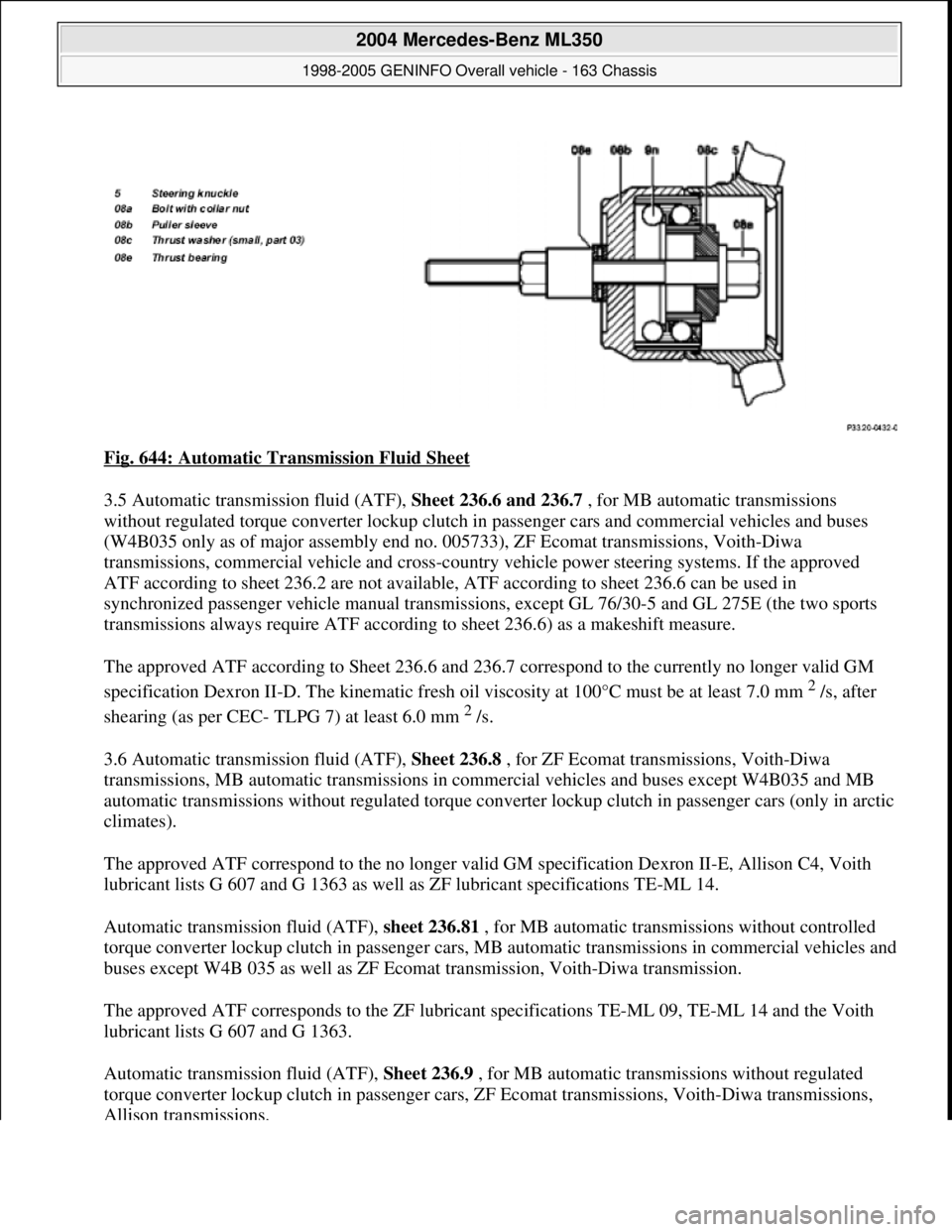
Fig. 644: Automatic Transmission Fluid Sheet
3.5 Automatic transmission fluid (ATF), Sheet 236.6 and 236.7 , for MB automatic transmissions
without regulated torque converter lockup clutch in passenger cars and commercial vehicles and buses
(W4B035 only as of major assembly end no. 005733), ZF Ecomat transmissions, Voith-Diwa
transmissions, commercial vehicle and cross-country vehicle power steering systems. If the approved
ATF according to sheet 236.2 are not available, ATF according to sheet 236.6 can be used in
synchronized passenger vehicle manual transmissions, except GL 76/30-5 and GL 275E (the two sports
transmissions always require ATF according to sheet 236.6) as a makeshift measure.
The approved ATF according to Sheet 236.6 and 236.7 correspond to the currently no longer valid GM
specification Dexron II-D. The kinematic fresh oil viscosity at 100°C must be at least 7.0 mm
2 /s, after
shearing (as per CEC- TLPG 7) at least 6.0 mm
2 /s.
3.6 Automatic transmission fluid (ATF), Sheet 236.8 , for ZF Ecomat transmissions, Voith-Diwa
transmissions, MB automatic transmissions in commercial vehicles and buses except W4B035 and MB
automatic transmissions without regulated torque converter lockup clutch in passenger cars (only in arctic
climates).
The approved ATF correspond to the no longer valid GM specification Dexron II-E, Allison C4, Voith
lubricant lists G 607 and G 1363 as well as ZF lubricant specifications TE-ML 14.
Automatic transmission fluid (ATF), sheet 236.81 , for MB automatic transmissions without controlled
torque converter lockup clutch in passenger cars, MB automatic transmissions in commercial vehicles and
buses except W4B 035 as well as ZF Ecomat transmission, Voith-Diwa transmission.
The approved ATF corresponds to the ZF lubricant specifications TE-ML 09, TE-ML 14 and the Voith
lubricant lists G 607 and G 1363.
Automatic transmission fluid (ATF), Sheet 236.9 , for MB automatic transmissions without regulated
torque converter lockup clutch in passenger cars, ZF Ecomat transmissions, Voith-Diwa transmissions,
Allison transmissions.
2004 Mercedes-Benz ML350
1998-2005 GENINFO Overall vehicle - 163 Chassis
me
Saturday, October 02, 2010 3:47:56 PMPage 505 © 2006 Mitchell Repair Information Company, LLC.